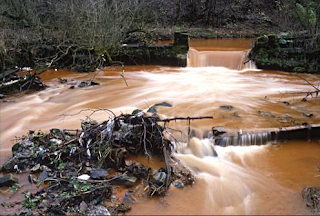Environment
Monday, April 11, 2011
Katse Dam, Lesotho
The weight of the water diverted into this reservoir by the Katse Dam in the southern African country of Lesotho caused minor earthquakes and damaged houses in surrounding villages. The dam, which is 182 meters high, represents the first phase of the Lesotho Highlands Water Project. Despite environmental concerns and allegations that several companies competing for project contracts violated international policies, the Highlands Water Project is scheduled for completion in 2015.
Shrinking Greenland Ice Sheet
The Greenland ice sheet underwent extensive surface melting from 1992 to 2002, according to the Arctic Climate Impact Assessment report released in 2004. Tinted areas in these satellite images show the extent of surface melting in 1992 and in 2002. The report warned that the melting of Greenland’s ice sheet and the melting of glaciers in Alaska and Canada are increasingly contributing to a rise in the world’s sea level.
Ozone Layer Hole
The ozone hole over the South Pole is apparent in this false-color image taken by a satellite in October 1999. Low levels of ozone are shown in blue. Ozone is a gas that blocks harmful ultraviolet sunlight. Industrial chemicals released into the atmosphere have caused ozone to break down, opening holes in the ozone layer that tend to concentrate at the poles.
Gully Formation Due to Soil Erosion
Gully formation, a severe form of soil erosion, is a natural geologic process that can be greatly accelerated by human activities such as urbanization, deforestation, overgrazing of cattle, and poor agricultural practices. Erosion attacks the moisture-bearing ability of soils and adds deposits to waterways. These destructive processes continue at an increased rate on every continent, as overpopulation and industrialization tax the remaining soil.
Satellite Images of Deforestation
These satellite images show the same section of a Brazilian rain forest found along the Amazon river taken in 1975, left, 1986, center, and 1992, right. The diagonal striations indicate the progressive destruction of trees over a 17-year period. Among the human activities leading to this widespread deforestation are commercial logging, agriculture, mining, and oil exploration as well as small-scale subsistence activities, such as slash-and-burn agriculture, charcoal production, and firewood collection. Fire is used as the primary means to clear forests for agriculture and development, a dangerous method that frequently escapes control and destroys large areas of forest.
Automobile Traffic Pollution
Automobile exhaust contains unburned hydrocarbons, particulates, carbon dioxide, and oxides of nitrogen and sulfur that contribute to acid rain, smog, and global warming. The oxides combine with water vapor in the air to form acids, which return to the ground as acid rain. Smog, a mixture of smoke (particulates) and fog, irritates the eyes, throat, and lungs and also damages plants. Photochemical smog, a particularly harsh form of smog, is created when sunlight triggers a chemical reaction between the unburned hydrocarbons and the oxides of nitrogen in automobile exhaust. Carbon dioxide, produced from the burning of fossil fuels including gasoline, is the leading cause of the greenhouse effect, a phenomenon thought to be responsible for rising global temperatures.
Spruce Forest Damaged by Acid Rain
Forests, lakes, ponds, and other terrestrial and aquatic environments throughout the world are being severely damaged by the effects of acid rain. Acid rain is caused by the combination of sulfur dioxide and nitrogen compounds with water in the atmosphere to produce rain with a very low pH. Normally, rainwater has a pH of 6.5, making it slightly acidic. However, with the addition of sulfur and nitrogen compounds, the pH of rainwater may drop to as low as 2.0 or 3.0, making it dangerously acidic. In addition to chemically burning the leaves of plants, acid rain poisons lake water, which kills most if not all of the aquatic inhabitants.
Industrial Smokestacks
Carbon dioxide, sulfur dioxide, and other types of contaminants pouring from industrial smokestacks contribute to worldwide atmospheric pollution. Carbon dioxide contributes significantly to global warming, while sulfur dioxide is the principal cause of acid rain in the northeastern United States, southeastern Canada, and eastern Europe. Other environmental problems stemming from smokestack emissions include respiratory diseases, poisoned lakes and streams, and damaged forests and crops.
Brown Smog Over Phoenix, Arizona
Smog is caused by industrial and automobile pollution. It is compounded by temperature inversions, which cause the air pollution to be kept in a particular area for extended periods. Continued exposure to smog can result in respiratory problems, eye irritation, and even death.
Polluted River in the United Kingdom
The pollution of rivers and streams with chemical contaminants has become one of the most critical environmental problems of the century. Chemical pollution entering rivers and streams can be classified according to the nature of its sources: point pollution and nonpoint pollution. Point pollution involves pollution from a single concentrated source that can be identified, such as an outfall pipe from a factory or refinery. Nonpoint pollution involves pollution from dispersed sources that cannot be precisely identified, such as runoff from agricultural or mining operations or seepage from septic tanks or sewage drain fields.
Earth Portrait
In conjunction with the 30th anniversary of Earth Day on April 22, 2000, scientists at the National Aeronautics and Space Administration (NASA) released the latest image of the Earth taken from space. The composite image is based on data collected from several satellites in 1997. Hurricane Linda can be seen raging off the west coast of Mexico, and an enlarged image of the moon is visible in the background.
Earth Summit, 1992
The United Nations Conference on Environment and Development, also called the Earth Summit, was held for 12 days in June 1992. Representatives from 178 countries attended the summit in Rio de Janeiro, Brazil. In this photo then-United States senator and vice-presidential candidate Al Gore addressed the audience.
Subscribe to:
Comments (Atom)











